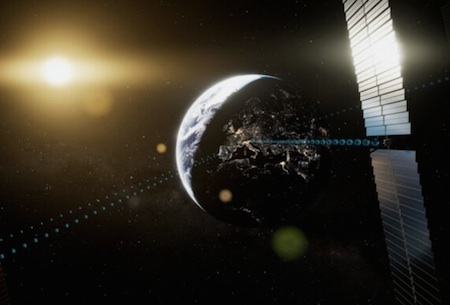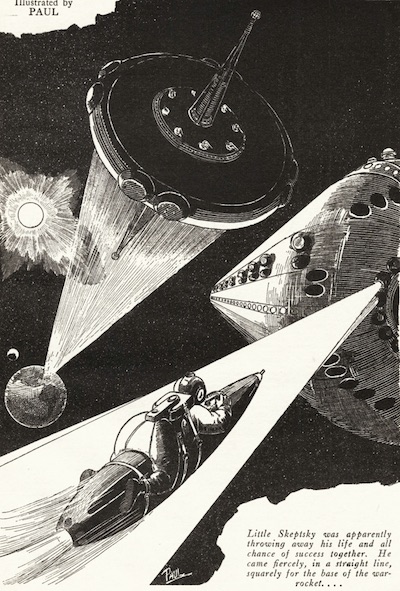Science Fiction
Dictionary
A B C D E F G H I J K L M N O P Q R S T U V W X Y Z
Space-Based Solar Power A Priority - European Space Agency

Space-based solar power is under serious consideration by the European Union, according to Josef Aschbacher, director general of the ESA space agency, an intergovernmental organization of 22 member states.

(Harvesting sunlight from Earth orbit and then beaming it down to the surface)
"It will be up to Europe, ESA and its Member States to push the envelope of technology to solve one of the most pressing problems for people on Earth of this generation," said Aschbacher...In concept, space-based solar power is fairly straightforward. Satellites orbiting well above Earth's atmosphere collect solar energy and convert it into current; this energy is then beamed back to Earth via microwaves, where they are captured by photovoltaic cells or antennas and converted into electricity for residential or industrial use. The primary benefits of gathering solar power from space, rather than on the ground, is that there is no night or clouds to interfere with collection; and the solar incidence is much higher than at the northern latitudes of the European continent.
[However] facilitating space-based solar power would require a constellation of dozens of huge, sunlight-gathering satellites located 36,000 km from Earth. Each of these satellites would have a mass 10 times larger, or more, than that of the International Space Station, which is 450 metric tons and required more than a decade to assemble in low Earth orbit. Launching the components of these satellites would ultimately require hundreds or, more likely, thousands of launches by heavy lift rockets.
(Via arstechnica.)
Science fiction writers have long pondered this idea. As far as I know, the earliest description of the basic idea is the power planet from Power Planet, by Murray Leinster and published by Amazing Stories in 1931:
The Power Planet, of course, is that vast man-made disk of metal set spinning about the sun to supply the Earth with power. Everybody learns in his grammar-school textbooks of its construction just beyond the Moon and of its maneuvering to its present orbit by a vast expenditure of rocket fuel.
('Power Planet' by Murray Leinster)Only forty million miles from the sun's surface, its sunward side is raised nearly to red heat by the blazing radiation. And the shadow side, naturally, is down to the utter cold of space. There is a temperature drop of nearly seven hundred degrees between the two sides, and Williamson cells turn that heat-difference into electric current, with an efficiency of 99 percent. Then the big Dugald tubes - they are twenty feet long on the Power Planet - transform it into the beam which is focused on the Earth and delivers something over a billion horsepower to the various receivers that have been erected...
(Read more about Murray Leinster's solar power satellite)
Scroll down for more stories in the same category. (Story submitted 8/21/2022)
Follow this kind of news @Technovelgy.| Email | RSS | Blog It | Stumble | del.icio.us | Digg | Reddit |
Would
you like to contribute a story tip?
It's easy:
Get the URL of the story, and the related sf author, and add
it here.
Comment/Join discussion ( 0 )
Related News Stories - (" Space Tech ")
Will Space Stations Have Large Interior Spaces Again?
'They filed clumsily into the battleroom, like children in a swimming pool for the first time, clinging to the handholds along the side.' - Orson Scott Card, 1985.
Reflect Orbital Offers 'Sunlight on Demand' And Light Pollution
'I don't have to tell you about the seven two-mile-diameter orbital mirrors...'
Chrysalis Generation Ship to Alpha Centauri
'This was their world, their planet —
this swift-traveling, yet seemingly moveless vessel.' - Nat Schachner, 1934
The First Space Warship For Space Force
'Each of the electrical ships carried about twenty men...' - Garrett P. Serviss, 1898.
Technovelgy (that's tech-novel-gee!) is devoted to the creative science inventions and ideas of sf authors. Look for the Invention Category that interests you, the Glossary, the Invention Timeline, or see what's New.
Science Fiction
Timeline
1600-1899
1900-1939
1940's 1950's
1960's 1970's
1980's 1990's
2000's 2010's
Current News
Natural Gait With Prosthetic Connected To Nervous System
'The leg was to function, in a way, as a servo-mechanism operated by Larry’s brain...'
Woman Marries Computer, Vonnegut's Dream Comes True
'Men are made of protoplasm... Lasts forever.'
Spidery 'Walk Me' Toyota Autonomous Wheel Chair Like Star Wars
Walk along with the emperor.
Dancing Robots Taught Dance Moves
'A clockwork figure would be the thing for you...'
Proof Of Robothood - Not A Person
'Who are you people? - Show 'em.'
Indonesian Clans Battle
'The observation vehicle was of that peculiar variety used in conveying a large number of people across rough terrain.'
The 'Last Mile' In China Crowded With Delivery Robots
Yes, it's a delivery robot. On wheels.
Tornyol Microdrone Kills Mosquitoes
'The real border was defended by... a swarm of quasi-independent aerostats.'
PLATO Spacecraft, Hunter Of Habitable Planets, Now Ready
'I ... set my automatic astronomical instruments to searching for a habitable planet.'
Factory Humanoid Robots Built By Humanoid Robots
'...haven't you a section of the factory where only robot labor is employed?'
iPhone Air Fulfils Jobs' Promise From 2007 - A Giant Screen!
'... oblongs were all over the floor and surfaces.'
ChatGPT Now Participates in Group Chats
'...the city was their laboratory in human psychology.'
iPhone Pocket All Sold Out!
'A long, strong, slender net...'
Did The Yautja Have These First?
What a marvel of ingenuity the little device was!
Jetson ONE Air Races Begin, Can Air Polo Be Far Behind?
'If you're one of those rarities who haven't attended a rocket-polo "carnage", let me tell you it's a colorful affair.'
Will Space Stations Have Large Interior Spaces Again?
'They filed clumsily into the battleroom, like children in a swimming pool for the first time, clinging to the handholds along the side.'

